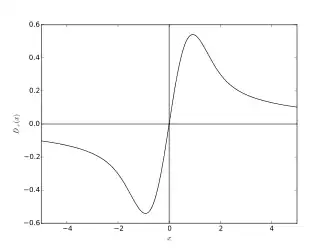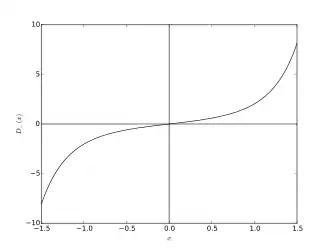Plot of the Dawson integral function F(z) in the complex plane from -2-2i to 2+2i with colors created with Mathematica 13.1 function ComplexPlot3D In mathematics , the Dawson function or Dawson integral [ 1] H. G. Dawson [ 2] sine transform of the Gaussian function.
Definition
The Dawson function,
F
(
x
)
=
D
+
(
x
)
,
{\displaystyle F(x)=D_{+}(x),}
The Dawson function,
D
−
(
x
)
,
{\displaystyle D_{-}(x),}
The Dawson function is defined as either:
D
+
(
x
)
=
e
−
x
2
∫
0
x
e
t
2
d
t
,
{\displaystyle D_{+}(x)=e^{-x^{2}}\int _{0}^{x}e^{t^{2}}\,dt,}
F
(
x
)
{\displaystyle F(x)}
D
(
x
)
,
{\displaystyle D(x),}
D
−
(
x
)
=
e
x
2
∫
0
x
e
−
t
2
d
t
.
{\displaystyle D_{-}(x)=e^{x^{2}}\int _{0}^{x}e^{-t^{2}}\,dt.\!}
The Dawson function is the one-sided Fourier–Laplace sine transform of the Gaussian function ,
D
+
(
x
)
=
1
2
∫
0
∞
e
−
t
2
/
4
sin
(
x
t
)
d
t
.
{\displaystyle D_{+}(x)={\frac {1}{2}}\int _{0}^{\infty }e^{-t^{2}/4}\,\sin(xt)\,dt.}
It is closely related to the error function erf, as
D
+
(
x
)
=
π
2
e
−
x
2
erfi
(
x
)
=
−
i
π
2
e
−
x
2
erf
(
i
x
)
{\displaystyle D_{+}(x)={{\sqrt {\pi }} \over 2}e^{-x^{2}}\operatorname {erfi} (x)=-{i{\sqrt {\pi }} \over 2}e^{-x^{2}}\operatorname {erf} (ix)}
where erfi is the imaginary error function, erfi(x ) = −i erf(ix ).
D
−
(
x
)
=
π
2
e
x
2
erf
(
x
)
{\displaystyle D_{-}(x)={\frac {\sqrt {\pi }}{2}}e^{x^{2}}\operatorname {erf} (x)}
In terms of either erfi or the Faddeeva function
w
(
z
)
,
{\displaystyle w(z),}
complex plane :[ 3]
F
(
z
)
=
π
2
e
−
z
2
erfi
(
z
)
=
i
π
2
[
e
−
z
2
−
w
(
z
)
]
,
{\displaystyle F(z)={{\sqrt {\pi }} \over 2}e^{-z^{2}}\operatorname {erfi} (z)={\frac {i{\sqrt {\pi }}}{2}}\left[e^{-z^{2}}-w(z)\right],}
D
+
(
x
)
=
F
(
x
)
=
π
2
Im
[
w
(
x
)
]
{\displaystyle D_{+}(x)=F(x)={\frac {\sqrt {\pi }}{2}}\operatorname {Im} [w(x)]}
D
−
(
x
)
=
i
F
(
−
i
x
)
=
−
π
2
[
e
x
2
−
w
(
−
i
x
)
]
{\displaystyle D_{-}(x)=iF(-ix)=-{\frac {\sqrt {\pi }}{2}}\left[e^{x^{2}}-w(-ix)\right]}
x
.
{\displaystyle x.}
For
|
x
|
{\displaystyle |x|}
F (x ) ≈ x .
|
x
|
{\displaystyle |x|}
F (x ) ≈ 1/(2x ).
F
(
x
)
=
∑
k
=
0
∞
(
−
1
)
k
2
k
(
2
k
+
1
)
!
!
x
2
k
+
1
=
x
−
2
3
x
3
+
4
15
x
5
−
⋯
,
{\displaystyle F(x)=\sum _{k=0}^{\infty }{\frac {(-1)^{k}\,2^{k}}{(2k+1)!!}}\,x^{2k+1}=x-{\frac {2}{3}}x^{3}+{\frac {4}{15}}x^{5}-\cdots ,}
x
{\displaystyle x}
F
(
x
)
=
1
2
x
+
1
4
x
3
+
3
8
x
5
+
⋯
.
{\displaystyle F(x)={\frac {1}{2x}}+{\frac {1}{4x^{3}}}+{\frac {3}{8x^{5}}}+\cdots .}
More precisely
|
F
(
x
)
−
∑
k
=
0
N
(
2
k
−
1
)
!
!
2
k
+
1
x
2
k
+
1
|
≤
C
N
x
2
N
+
3
.
{\displaystyle \left|F(x)-\sum _{k=0}^{N}{\frac {(2k-1)!!}{2^{k+1}x^{2k+1}}}\right|\leq {\frac {C_{N}}{x^{2N+3}}}.}
n
!
!
{\displaystyle n!!}
double factorial .
F
(
x
)
{\displaystyle F(x)}
d
F
d
x
+
2
x
F
=
1
{\displaystyle {\frac {dF}{dx}}+2xF=1\,\!}
F
(
0
)
=
0.
{\displaystyle F(0)=0.}
F
(
x
)
=
1
2
x
,
{\displaystyle F(x)={\frac {1}{2x}},}
x = ±0.92413887... (OEIS : A133841 F (x ) = ±0.54104422... (OEIS : A133842
Inflection points follow for
F
(
x
)
=
x
2
x
2
−
1
,
{\displaystyle F(x)={\frac {x}{2x^{2}-1}},}
x = ±1.50197526... (OEIS : A133843 F (x ) = ±0.42768661... (OEIS : A245262 inflection point at
x
=
0
,
{\displaystyle x=0,}
F
(
x
)
=
0.
{\displaystyle F(x)=0.}
The Hilbert transform of the Gaussian is defined as
H
(
y
)
=
π
−
1
P
.
V
.
∫
−
∞
∞
e
−
x
2
y
−
x
d
x
{\displaystyle H(y)=\pi ^{-1}\operatorname {P.V.} \int _{-\infty }^{\infty }{\frac {e^{-x^{2}}}{y-x}}\,dx}
P.V. denotes the Cauchy principal value , and we restrict ourselves to real
y
.
{\displaystyle y.}
H
(
y
)
{\displaystyle H(y)}
1
/
u
{\displaystyle 1/u}
generalized function or distribution, and use the Fourier representation
1
u
=
∫
0
∞
d
k
sin
k
u
=
∫
0
∞
d
k
Im
e
i
k
u
.
{\displaystyle {1 \over u}=\int _{0}^{\infty }dk\,\sin ku=\int _{0}^{\infty }dk\,\operatorname {Im} e^{iku}.}
With
1
/
u
=
1
/
(
y
−
x
)
,
{\displaystyle 1/u=1/(y-x),}
sin
(
k
u
)
{\displaystyle \sin(ku)}
x
{\displaystyle x}
π
H
(
y
)
=
Im
∫
0
∞
d
k
exp
[
−
k
2
/
4
+
i
k
y
]
∫
−
∞
∞
d
x
exp
[
−
(
x
+
i
k
/
2
)
2
]
.
{\displaystyle \pi H(y)=\operatorname {Im} \int _{0}^{\infty }dk\,\exp[-k^{2}/4+iky]\int _{-\infty }^{\infty }dx\,\exp[-(x+ik/2)^{2}].}
We can shift the integral over
x
{\displaystyle x}
π
1
/
2
.
{\displaystyle \pi ^{1/2}.}
π
1
/
2
H
(
y
)
=
Im
∫
0
∞
d
k
exp
[
−
k
2
/
4
+
i
k
y
]
.
{\displaystyle \pi ^{1/2}H(y)=\operatorname {Im} \int _{0}^{\infty }dk\,\exp[-k^{2}/4+iky].}
We complete the square with respect to
k
{\displaystyle k}
π
1
/
2
H
(
y
)
=
e
−
y
2
Im
∫
0
∞
d
k
exp
[
−
(
k
/
2
−
i
y
)
2
]
.
{\displaystyle \pi ^{1/2}H(y)=e^{-y^{2}}\operatorname {Im} \int _{0}^{\infty }dk\,\exp[-(k/2-iy)^{2}].}
We change variables to
u
=
i
k
/
2
+
y
:
{\displaystyle u=ik/2+y:}
π
1
/
2
H
(
y
)
=
−
2
e
−
y
2
Im
i
∫
y
i
∞
+
y
d
u
e
u
2
.
{\displaystyle \pi ^{1/2}H(y)=-2e^{-y^{2}}\operatorname {Im} i\int _{y}^{i\infty +y}du\ e^{u^{2}}.}
The integral can be performed as a contour integral around a rectangle in the complex plane. Taking the imaginary part of the result gives
H
(
y
)
=
2
π
−
1
/
2
F
(
y
)
{\displaystyle H(y)=2\pi ^{-1/2}F(y)}
F
(
y
)
{\displaystyle F(y)}
The Hilbert transform of
x
2
n
e
−
x
2
{\displaystyle x^{2n}e^{-x^{2}}}
H
n
=
π
−
1
P
.
V
.
∫
−
∞
∞
x
2
n
e
−
x
2
y
−
x
d
x
.
{\displaystyle H_{n}=\pi ^{-1}\operatorname {P.V.} \int _{-\infty }^{\infty }{\frac {x^{2n}e^{-x^{2}}}{y-x}}\,dx.}
Introduce
H
a
=
π
−
1
P
.
V
.
∫
−
∞
∞
e
−
a
x
2
y
−
x
d
x
.
{\displaystyle H_{a}=\pi ^{-1}\operatorname {P.V.} \int _{-\infty }^{\infty }{e^{-ax^{2}} \over y-x}\,dx.}
The
n
{\displaystyle n}
∂
n
H
a
∂
a
n
=
(
−
1
)
n
π
−
1
P
.
V
.
∫
−
∞
∞
x
2
n
e
−
a
x
2
y
−
x
d
x
.
{\displaystyle {\partial ^{n}H_{a} \over \partial a^{n}}=(-1)^{n}\pi ^{-1}\operatorname {P.V.} \int _{-\infty }^{\infty }{\frac {x^{2n}e^{-ax^{2}}}{y-x}}\,dx.}
We thus find
H
n
=
(
−
1
)
n
∂
n
H
a
∂
a
n
|
a
=
1
.
{\displaystyle \left.H_{n}=(-1)^{n}{\frac {\partial ^{n}H_{a}}{\partial a^{n}}}\right|_{a=1}.}
The derivatives are performed first, then the result evaluated at
a
=
1.
{\displaystyle a=1.}
H
a
=
2
π
−
1
/
2
F
(
y
a
)
.
{\displaystyle H_{a}=2\pi ^{-1/2}F(y{\sqrt {a}}).}
F
′
(
y
)
=
1
−
2
y
F
(
y
)
,
{\displaystyle F'(y)=1-2yF(y),}
H
n
=
P
1
(
y
)
+
P
2
(
y
)
F
(
y
)
{\displaystyle H_{n}=P_{1}(y)+P_{2}(y)F(y)}
P
1
{\displaystyle P_{1}}
P
2
{\displaystyle P_{2}}
H
1
=
−
π
−
1
/
2
y
+
2
π
−
1
/
2
y
2
F
(
y
)
.
{\displaystyle H_{1}=-\pi ^{-1/2}y+2\pi ^{-1/2}y^{2}F(y).}
H
n
{\displaystyle H_{n}}
recurrence relation (for
n
≥
0
{\displaystyle n\geq 0}
H
n
+
1
(
y
)
=
y
2
H
n
(
y
)
−
(
2
n
−
1
)
!
!
π
2
n
y
.
{\displaystyle H_{n+1}(y)=y^{2}H_{n}(y)-{\frac {(2n-1)!!}{{\sqrt {\pi }}2^{n}}}y.}
See also
References
^ Temme, N. M. (2010), "Error Functions, Dawson's and Fresnel Integrals" , in Olver, Frank W. J. ; Lozier, Daniel M.; Boisvert, Ronald F.; Clark, Charles W. (eds.), NIST Handbook of Mathematical Functions ISBN 978-0-521-19225-5 , MR 2723248 ^ Dawson, H. G. (1897). "On the Numerical Value of
∫
0
h
exp
(
x
2
)
d
x
{\displaystyle \textstyle \int _{0}^{h}\exp(x^{2})\,dx}
. Proceedings of the London Mathematical Society . s1-29 (1): 519– 522. doi :10.1112/plms/s1-29.1.519 . ^ Mofreh R. Zaghloul and Ahmed N. Ali, "Algorithm 916: Computing the Faddeyeva and Voigt Functions ," ACM Trans. Math. Soft. 38 (2), 15 (2011). Preprint available at arXiv:1106.0151 .
External links
_in_the_complex_plane_from_-2-2i_to_2%252B2i_with_colors_created_with_Mathematica_13.1_function_ComplexPlot3D.svg.png)

